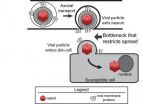(Press-News.org) Clinicians should take caution when diagnosing a child who has a high fever and whose tests show evidence of adenovirus, and not assume the virus is responsible for Kawasaki-like symptoms. According to a new study from Nationwide Children's Hospital appearing in Clinical Infectious Diseases, adenovirus detection is not uncommon among children with Kawasaki disease.
Kawasaki disease is a rare but serious condition in children that involves inflammation of the blood vessels, specifically the heart vessels that supply the heart tissue or coronary arteries. It is the most common cause of pediatric acquired heart disease in the developed world. Children with Kawasaki disease or illness caused by adenoviruses often first present with a high and persistent fever. Early diagnosis for Kawasaki disease before the tenth day of fever is essential to prevent sequelae in the heart.
"Kawasaki disease and acute adenoviral infection can present with many of the same clinical characteristics," says Preeti Jaggi, MD, member of the Section of Infectious Diseases at Nationwide Children's and lead study author. "Given the similarities, human adenovirus infection is one of the most frequent conditions included on the differential diagnosis when considering Kawasaki disease." However, few data are available regarding the differences in frequency, viral load and types of detectable human adenovirus in Kawasaki disease patients and in children who have adenovirus disease that mimicks Kawasaki disease.
The study aimed to determine whether there are differences in the amount of human adenovirus in the upper airway in children with human adenovirus infection versus those diagnosed with Kawasaki disease. Dr. Jaggi and her team compared Kawasaki disease patients who were positive for human adenovirus infection with other patients diagnosed with human adenovirus infection during a two year period at Nationwide Children's. Among 77 Kawasaki disease patients, nearly 13 percent had human adenovirus detected.
"Evidence suggests that human adenovirus strains can persist in pediatric adenoids and tonsils and are capable of low level shedding. PCR analysis can detect non-replicating virus," says Dr. Jaggi, also assistant professor of Clinical Pediatrics at The Ohio State University College of Medicine. "This may explain why PCR, but not viral culture, could detect human adenovirus in these Kawasaki disease patients."
The findings indicate that detection of human adenovirus in a patient with suspected Kawasaki disease should be interpreted with caution. "Detection of human adenovirus in these patients is fairly common and does not exclude the diagnosis of Kawasaki disease," says Dr. Jaggi.
According to Dr. Jaggi, quantitative PCR, culture and human adenovirus typing methods may help distinguish human adenovirus disease mimicking Kawasaki disease from Kawasaki disease with accompanying human adenovirus detection.
###
For more information on Dr. Preeti Jaggi, visit http://www.nationwidechildrens.org/preeti-jaggi
For more information on Infectious Diseases at Nationwide Children's, visit http://www.nationwidechildrens.org/infectious-diseases
For more information on Kawasaki Disease, visit http://healthlibrary.nationwidechildrens.org/Library/Encyclopedia/90,P01801
High fever and evidence of a virus? Caution, it still may be Kawasaki disease
Study finds that a Kawasaki disease-mimicking virus is not uncommon among children with Kawasaki disease
2012-11-05
ELSE PRESS RELEASES FROM THIS DATE:
Scientists identify insect-repelling compounds in Jatropha
2012-11-05
This press release is available in Spanish.
A tip about a folk remedy plant used in India and Africa to ward off bugs has led to the discovery of insect-repelling compounds.
U.S. Department of Agriculture (USDA) scientists have identified components of Jatropha curcas seed oil that are responsible for mosquito repellency. Researchers at the Agricultural Research Service (ARS) Natural Products Utilization Research Unit (NPURU) in Oxford, Miss., often find effective plant-derived compounds to deter insects by gathering plants in the wild and investigating those used ...
Loser-pays-all rule in criminal cases could work for wealthy defendants
2012-11-05
CHAMPAIGN, Ill. — Adopting a loser-pays-all rule for criminal litigation would likely be feasible only if the rule applied to defendants who are wealthy, says a study from a University of Illinois law professor.
Nuno Garoupa, the H. Ross and Helen Workman Research Scholar in the College of Law, says a loser-pays-all rule could deter some crime when it's applied to either a corporation or an individual with deep pockets. But when defendants are not wealthy, such cost-shifting would be "wholly inappropriate," he says.
"On the defendant's side, the problem is that a significant ...
Checklists in the operating room: More safety for patients
2012-11-05
The use of the World Health Organization's Surgical Safety Checklist in the operating room considerably lowers the risks of surgery. This is the conclusion of Axel Fudickar and co-authors in their article in Issue 42 of Deutsches Ärzteblatt International (Dtsch Arztebl Int 2012; 109(42): 695).
The most common errors in safety-related behavior in the operating room are attributable to inadequate communication and teamwork. The Surgical Safety Checklist, which was introduced by the World Health Organization in 2007, has the main effect of improving commmunication of the ...
2001-2002 drought helped propel mountain pine beetle epidemic, says CU study
2012-11-05
A new University of Colorado Boulder study shows for the first time that episodes of reduced precipitation in the southern Rocky Mountains, especially during the 2001-02 drought, greatly accelerated development of the mountain pine beetle epidemic.
The study, the first ever to chart the evolution of the current pine beetle epidemic in the southern Rocky Mountains, compared patterns of beetle outbreak in the two primary host species, the ponderosa pine and lodgepole pine, said CU-Boulder doctoral student Teresa Chapman. The current mountain pine beetle outbreak in the ...
Spinal cord injury puts patients at high risk of life-threatening cardiovascular events
2012-11-05
New Rochelle, NY, November 5, 2012—Spinal cord injury (SCI) can disrupt the body's sensitive signaling mechanisms that control blood pressure, breathing, and oxygen delivery to the heart and other organs during changes in body position. Cardiovascular (CV) disease is a leading cause of illness and death following SCI, and changes in baroreflex sensitivity—the body's ability to detect and respond to changes in blood pressure—may be predictive of a CV event. A comprehensive review article on baroreflex sensitivity after SCI is published in Journal of Neurotrauma, a peer-reviewed ...
Etiologic diagnosis of nonsyndromic genetic hearing loss in adult vs pediatric populations
2012-11-05
Alexandria, VA — Genetic testing for a certain mutation in pediatric patients is valuable in determining a cause for unexplained hearing loss, according to a study in the November 2012 issue of Otolaryngology–Head and Neck Surgery.
The study's authors state that testing for some of the most common mutations that cause sensorineural hearing loss in a targeted way, rather than through generalized screening of hearing loss patients, yields the best results.
University of Miami NIH-funded researchers led by Dr. Xue Zhong Liu, a physician-scientist, conducted a nine-year ...
The knowing nose: Chemosignals communicate human emotions
2012-11-05
Many animal species transmit information via chemical signals, but the extent to which these chemosignals play a role in human communication is unclear. In a new study published in Psychological Science, a journal of the Association for Psychological Science, researcher Gün Semin and colleagues from Utrecht University in the Netherlands investigate whether we humans might actually be able to communicate our emotional states to each other through chemical signals.
Existing research suggests that emotional expressions are multi-taskers, serving more than one function. Fear ...
Study supports move toward common math standards
2012-11-05
EAST LANSING, Mich. — A new study analyzing the previous math standards of each state provides strong support for adoption of common standards, which U.S. students desperately need to keep pace with their counterparts around the globe, a Michigan State University scholar argues.
Forty-six states are implementing the Common Core math and reading standards, which nonetheless have come under fire recently by some researchers and would-be politicians.
But William Schmidt, MSU Distinguished Professor of statistics and education, said the Common Core is a world-class set ...
Waste management -- good marketing
2012-11-05
This press release is available in Spanish.
Spanish legislation on waste management changed in July last year. Until then, the consumer was responsible for the disposal of products. According to Mr Unai Tamayo, economist at the University of the Basque Country (UPV/EHU), the new laws "foment the construction of closed systems, such as in taverns: the container being taken out and subsequently returned. Moreover, when a manufacturer launches a product on to the market, once consumed, the packaging is considered waste, and the responsibility for this now falls on the manufacturer ...
Princeton researchers identify unexpected bottleneck in the spread of herpes simplex virus
2012-11-05
VIDEO:
Princeton University research suggests that a common strain of herpes virus causes cold sores with only one or two viral particles, resulting in a bottleneck in which the infection is...
Click here for more information.
New research suggests that just one or two individual herpes virus particles attack a skin cell in the first stage of an outbreak, resulting in a bottleneck in which the infection may be vulnerable to medical treatment.
Unlike most viruses that ...
LAST 30 PRESS RELEASES:
Scientists ID potential way to prevent brain injuries from triggering Alzheimer's
MASTER 2nd Open Call: Execution period kick-off
Algae for health in food and pharma
Advanced microrobots driven by acoustic and magnetic fields for biomedical applications
Chicago health information leader recognized for raising CPR readiness and blood pressure awareness
The Intimate Animal, a new book from Kinsey Institute Executive Director Dr. Justin Garcia
When blue-collar workers lose union protection, they try self-employment
New video dataset to advance AI for health care
MEA-based graph deviation network for early autism syndrome signatures in human forebrain organoids
New modeling approach sheds light on rare gut disease
Study documents potentially hazardous flame retardants in firefighter gear
Can certain bacteria regulate aging of the immune system and its related alterations?
AI model helps diagnose often undetected heart disease from simple EKG
There are fewer online trolls than people think
Cell membrane fluctuations produce electricity
Jeonbuk National University study shows positive parenting can protect adolescents against self-harm
Surface-engineered ZnO nanocrystals to tackle perfluoroalkyl substance contamination
This new understanding of T cell receptors may improve cancer immunotherapies
A new fossil face sheds light on early migrations of ancient human ancestor
A new immunotherapy approach could work for many types of cancer
A new way to diagnose deadly lung infections and save lives
40 percent of MRI signals do not correspond to actual brain activity
How brain-inspired algorithms could drive down AI energy costs
Gum disease may be linked to plaque buildup in arteries, higher risk of major CVD events
Contrails are a major driver of aviation’s climate impact
Structure of dopamine-releasing neurons relates to the type of circuits they form for smell-processing
Reducing social isolation protects the brain in later life
Keeping the heart healthy increases longevity even after cancer
Young adults commonly mix cannabis with nicotine and tobacco
Comprehensive review illuminates tau protein's dual nature in brain health, disease, and emerging psychiatric connections
[Press-News.org] High fever and evidence of a virus? Caution, it still may be Kawasaki diseaseStudy finds that a Kawasaki disease-mimicking virus is not uncommon among children with Kawasaki disease




